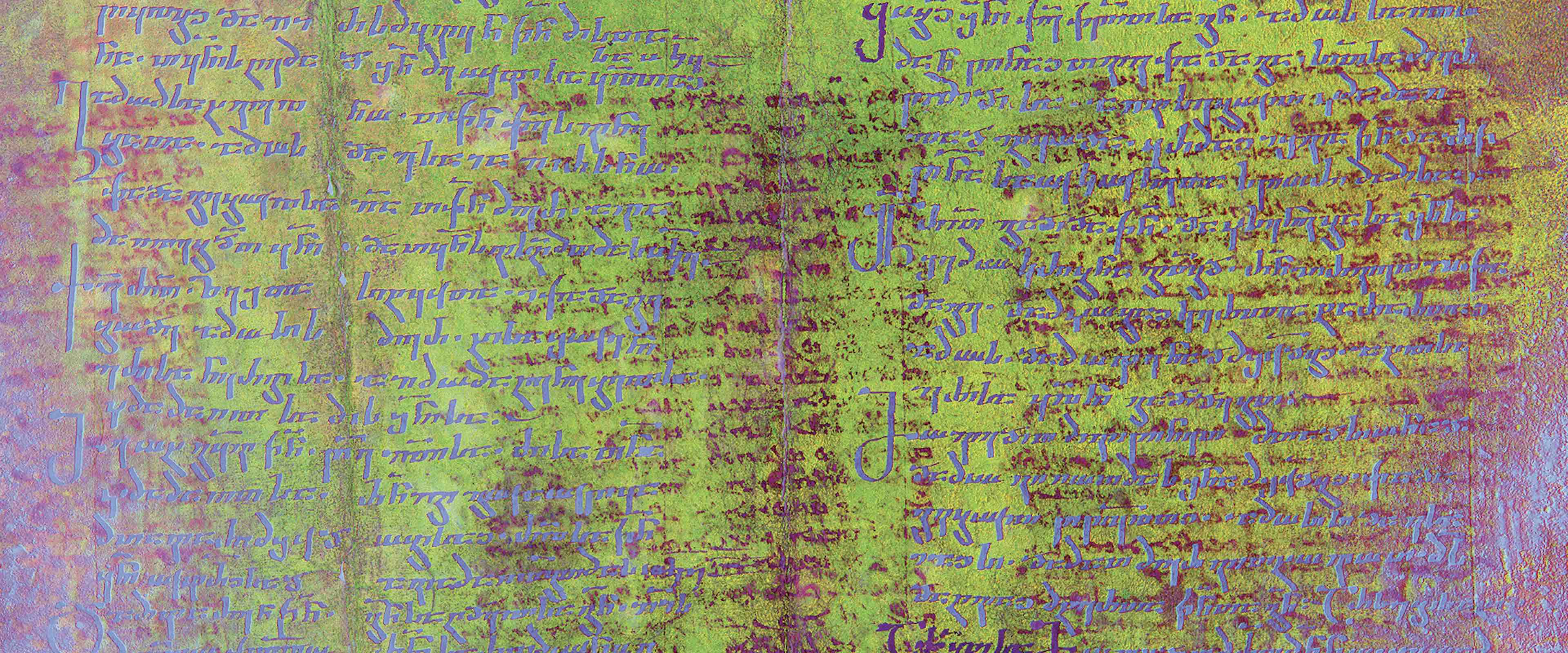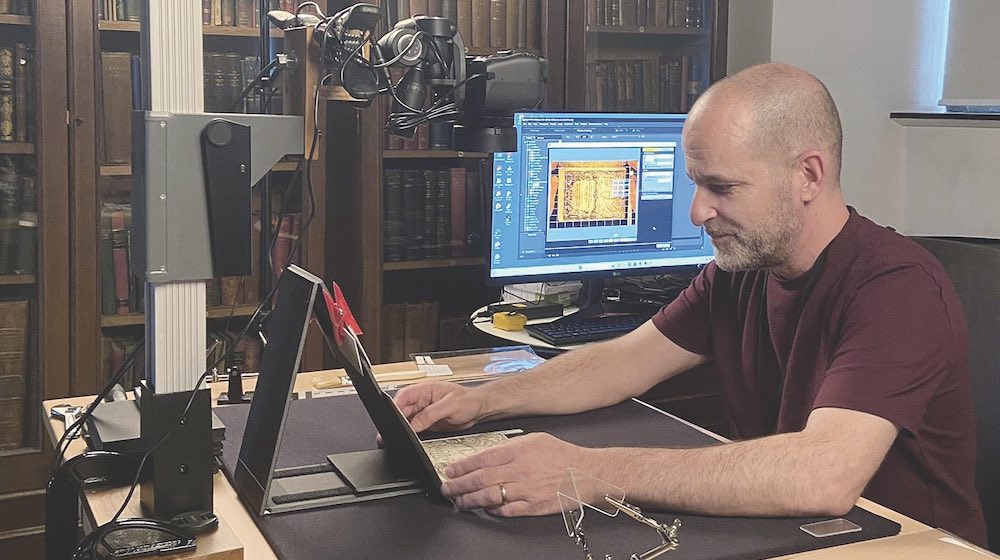Seeing The Invisible — Multispectral Imaging Of Ancient And Medieval Manuscripts
Seeing the Invisible — Multispectral Imaging of Ancient and Medieval Manuscripts
July 1, 2019This year marks twenty years since the first significant efforts were made to use multispectral imaging (MSI) to reveal hidden writing within a parchment manuscript (the book in question contained the lost works of ancient Greek mathematician Archimedes). This noninvasive technology is especially suited for work with parchment, a unique sheet material made from animal skin whose surface can be written upon and then miraculously ‘erased’ by scraping for reuse by a later scribe. In the ancient and medieval Mediterranean world this recycling was common. Texts came and went, but parchment was expensive and always valuable to scribes. Books no longer deemed necessary or desirable were sometimes unbound, and the parchment scraped down and reused to create what is called a palimpsest. Even when the earlier writing was not visible to the naked eye, traces of the ink remained embedded in the parchment sheet, bonded to the collagen and proteins in the skin. Multispectral imaging can reveal traces of this hidden writing.

The MSI process involves photographing the palimpsested manuscript folios with a variety of wavelengths of light ranging fr om ultraviolet to infrared. Each wavelength interacts differently with the manuscript surface, revealing details that can enhance the visibility of parchment, inks, pigments, surface treatments, or stains. Once the images are captured, they are digitally processed, selected, and united to form a single image that reveals details not visible to the naked eye. This technology has been developed over the last two decades by Mike Toth, in partnership with scientists and camera manufacturers. Toth was a member of the team that imaged the manuscript with the lost works of Archimedes in 1999 for the Archimedes Palimpsest Project at the Walters Art Gallery.
Since then, Toth has been using MSI to image manuscripts, maps, paintings, pottery, and even mummy masks made of recycled papyri containing ancient texts. The technology was devised for medical use, and then adapted to the imaging of manuscripts. Toth describes the work as highly collaborative, involving photographers, manuscript scholars, conservators, data specialists, computer engineers, and scientists.
Toth recently imaged a manuscript fragment from HMML’s collections (SJU Ms Frag 32), working with imaging scientist Bill Christens-Barry and R.B. Toth Associates-sponsored PhD student Cery Jones. The parchment bifolium (folded sheet) had been in HMML’s rare book vault for several decades, but was not brought to light until preparation for an exhibit on manuscript fragments was underway in 2016-17. It comes from a Georgian liturgical manuscript and has a faint trace of older underwriting visible to the naked eye. HMML’s Curator of Western Collections, Matthew Heintzelman, noticed the underwriting and brought it to the attention of Executive Director, Father Columba Stewart, who identified it as early Syriac and sent the fragment off to Toth and team for imaging. The resulting images revealed that Syriac text (seen here in two and a half red columns of writing) underneath the Georgian writing (wider columns in blue). As is common with palimpsested parchments, the original Syriac manuscript was larger than the later Georgian manuscript, and was scraped, cut down and reused (the center fold of the original Syriac manuscript is visible down the middle of the wide column of Georgian text on the left).
According to HMML’s Curator of Eastern Christian & Islamic Manuscripts, David Calabro, based on the peculiarities of the Syriac Estrangela script, the Syriac underwriting dates from the sixth to the eighth century. By any standard this makes it an early and rare fragment. Calabro’s preliminary work on the text with Adrian Pirtea, a HMML Swenson Family Fellow in Eastern Christian Manuscript Studies, revealed several words and strings of words in Syriac (such as ṭúbānā / “the blessed one”), which may place the book in the genre of hagiographical writing on the lives of saints. More will be revealed as Toth and Calabro collaborate to post-process different parts of the sheet to enhance visualization of particular areas of the Syriac text. Equally remarkable is the 1,000-year-old Georgian overwriting, from a 10th-century collection of chants including texts from the Prophets Habakkuk, Isaiah and Amos. This dating makes the Georgian text early as well. It is clear that this manuscript had a complicated life, likely produced in Mesopotamia (an area that today includes parts of Syria, Iraq, and southeastern Turkey) before being scraped down and reused by a Georgian scribe. This may have been done in northern Syria, where there were Georgian monastic communities in the medieval period such as at the Black Mountain near Antioch, or possibly at Saint Catherine’s Monastery, Sinai, Egypt. This fragment demonstrates how palimpsest witnesses both preserve valuable early texts and attest to the wide dissemination of Syriac literature throughout the eastern Mediterranean, offering a rich comparative perspective on the contacts between Syriac and other eastern Christian traditions.
Each imaging project presents its own set of challenges, but solving those data and processing hurdles adds knowledge useful for the future study of similar texts. For example, twenty years ago Toth and his collaborators knew little about the material characteristics of parchment and its fluorescence—its ability to absorb short wavelength and reflect long wavelength light. The understanding of parchment as a material has allowed Toth and researchers to refine the imaging process to enhance the visualization of embedded texts. Also, every project adds to the knowledge base and understanding of particular manuscript traditions, whether they are Syriac, Latin, Arabic, or Ethiopian. For example, parchment in Syriac manuscripts (such as SJU Ms Frag 32) is often high in calcium, which can interfere with a clear imaging of the underwriting (this may be due to the chalk required to degrease certain types of parchment skins for writing). Toth and his team now account for this codicological feature when imaging Syriac fragments such as HMML’s fragment or the famed Syriac Galen Palimpsest, a ninth-century Graeco-Syriac manuscript containing part of a pharmacological treatise by that ancient Greek physician. As the technology and knowledge base evolve, the growing data library of palimpsests from different traditions will allow technicians and researchers to get even more out of these texts. It will also lead to advancements in artificial intelligence and, in particular, machine learning, that will allow computers to teach themselves how to recognize and correct for differences in parchment, inks, and surface preparations from a variety of traditions.
The basic principles of MSI technology have stayed the same over the last two decades, and processing images has remained the terrain of a few technicians with the software and skills to create readable images from raw data. The next level of functionality for MSI will involve creating a suite of computer analysis tools that would allow anyone to enhance, refine, and interpret hidden texts more effectively on their own (women have the advantage, Toth says, as one in ten men is color blind). Toth and business partner, Bill Christens-Barry of Equipoise Imaging, are developing a “Paleo Toolbox” that will do just that. This would allow multispectral imaging technology to reach wider audiences who could analyze a larger number of palimpsest texts, some of which may have been hidden in plain sight for decades. Work with these palimpsests is certain to include the discovery of important lost works and the reinterpretation of little known texts that will reshape scholarship in many fields.




